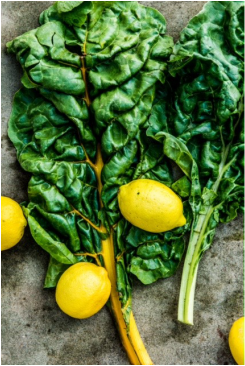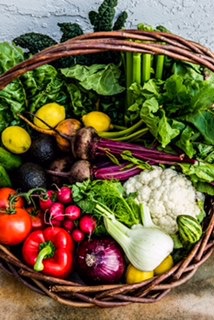|
Organic food is a much discussed topic. Some people believe that it is too expensive and others believe that it is a marketing ploy. It is important to educate people on the true value of organic foods so that they can make the best decision for themselves and for their family.  Purchasing whole, organic foods is particularly important because organic foods are more nutritious and provide the vitamins, minerals, and enzymes your body needs. They also inflict less of a toxic chemical load to the body and the environment due to the way farmers grow and process products like fruits, vegetables, dairy, grains, and meat. They donʼt use chemical fertilizers, herbicides, or antibiotics. Organic products also do not contain genetically modified organisms (GMOs) and are not processed using irradiation, industrial solvents, or artificial food additives. However, you do not have to buy all of your produce organic. A list put out by the Environmental Working Group (EWG) is helpful in identifying produce with the lowest (Clean 15) and the highest (Dirty Dozen) pesticide contamination. More about GMOs...  The World Health Organization (WHO) defines GMOs as organisms in which the genetic material (the DNA) has been altered in a way that does not occur naturally. There are no rules or regulations in the United States as to what parts of DNA can be used or even as to what species may be crossed with others. There is also no mandatory labeling for GMO foodstuffs. The majority of GMOs are food crops. Pesticides and herbicides developed from bacteria are inserted into the DNA of the food supply to make them resistant to the herbicide sprays. No long term safety studies have been conducted on the effects of exposure to or the consumption of GMOs, so we humans are literally a lab experiment for Monsanto, the world leader in GM crops and seeds. If you do not want to consume GMOs, read food labels carefully and avoid non- organic corn, soy, and sugar - three of the most GM crops. The Non-GMO project is an organization committed to building the non-GMO food supply in order to offer us some level of GMO transparency - now there’s an idea! It would be wise to seek out the “USDA Organic” label or the “Non-GMO Project Verified Seal” since GMOs are prohibited in products with these labels. Organic, local foods at a Farmer's Market Although organic, local foods can readily be found nowadays in supermarkets and in specialty food markets, you could shop at a Farmersʼ Market. For example, there are more than 14 weekly Farmersʼ Markets in the East Bay, CA. When shopping at the Farmers' Market, ask a farmer how the food was grown. The term organic refers to the way agricultural products are grown and produced. Many smaller farms are dedicated to organic farming practices, but cannot market their products as certified organic due to the rigorous and expensive process that they must go through in order to receive this designation. Why shop at a Farmersʼ Market?  To enjoy the freshest S.O.U.L. food of course...seasonal, organic, unprocessed, and local products, including fresh fruit, vegetables, cheese, eggs, fish, grass-fed meats, local honeys, and breads. These products take less packaging and less transportation, so you are helping the environment. Support your local farmers and be part of your community. Sources:
Hartwig, D. & M. (2012). It starts with food. Las Vegas, NV: VictoryBelt. Huff Post Green (2015). Retrieved from http://www.huffingtonpost.com/margie-kelly/genetically-modified-food_b_2039455.html Sacks, S. (2014). What the fork are you eating? New York, NY: Jeremy P. Tarcher/Penguin Sannapu, A. (2013). Are GMOs healthy? Retrieved from http://articles.herballegacy.com/what-are-gmos-are-they-healthy-and-natural/ World Health Organization. (2015). Retrieved from http://www.who.int/topics/food_genetically_modified/en/
2 Comments
 This is one of my favorite soups ever! It is so easy to make that even the most inexperienced cook will be successful in its creation. There are only four easy-to-find ingredients needed: butternut squash, chicken broth, fresh ginger, and Himalayan salt. If you choose to buy pre-cut butternut squash, it saves a lot of time. Although the recipe is extremely creamy, there is no cream (or any dairy for that matter) in the recipe. First roast the butternut squash and then put it and the remaining ingredients into a blender. The butternut squash becomes caramelized in the roasting process and this brings out its rich flavor. If you have a Vitamix blender with a hot soup setting, it heats it perfectly and you can serve the soup right from the blender. How cool is that? It is not necessary to add anything else to this recipe, but if you are feeling artistic and want to garnish the soup, toast some pumpkin seeds. These delicious and nutritious seeds are a good source of magnesium and zinc and add a crunch to the soup. This recipe serves 4. Butternut Squash Soup
Prep time: 5 minutes Cook time: 50 minutes Total time: 55 minutes Ingredients: • 16 ounce package cut butternut squash • 32 ounces Organic Free Range Chicken Broth • 1 -3 teaspoons fresh minced ginger, to taste • Himalayan salt, to taste Preparation: 1. Preheat oven to 400 degrees. 2. Place the butternut squash in a large glass pyrex dish. 3. Salt the butternut squash and toss with olive oil. 4. Roast for about 40 minutes or until soft. 5. Once the squash is cooked, remove it from the oven and place squash into high-powered blender along with enough chicken stock to cover the squash. You may need to do this in batches, depending on your blender. 6. Add fresh minced ginger to taste. I like ginger a lot, so I tend to use more. 7. Blend on high until consistency is creamy. 8. Add salt to taste. Enjoy immediately or save it for later. Place soup into mason jars and refrigerate. It can stay refrigerated for up to 4 days. I am often asked about diets and which ones are best. I suggest that people do not diet, but rather incorporate healthful eating habits into their lifestyle. One way to do this is to incorporate the 85/15 way of eating. This way of eating means that 85% of the time, you would be eating whole, nutrient-dense foods that are nourishing to the body, supplying needed vitamins, minerals, and enzymes. If you are eating healthfully 85% of the time, then the 15% of the time when you indulge in refined, nutrient depleting foods, your body will not suffer because you will have plenty of nutritional reserves on hand. But, what is a refined food and what constitutes a nourishing, whole food? Let's take a look. STANDARD AMERICAN DIET...IT IS VERY S.A.D.! The Standard American Diet, the diet that the majority of Americans eat today, is one that is highly processed, refined, and chemicalized. It is primarily made up of junk food and it includes high-sodium and high-fat components. The diet consists of regular use of dairy products, fatty meats, fried oily foods, salty and sugary snacks, coffees, sodas and other stimulating beverages such as alcohol, along with artificial flavorings and additives. You will find high amounts of white sugar and refined flour with this diet as seen in cereals, breads, pastries and doughnuts.  We are being profiled for being S.A.D. We are being profiled for being S.A.D. If you are someone who eats the Standard American Diet, you probably are eating only about 25- 30% of nutrient rich foods. That means that most of your food is refined. WHAT IS SO BAD ABOUT EATING REFINED FOODS? Eating refined foods forces the body to pull nutrients from the body’s reserves. The body first pulls from the bloodstream, then the tissues, organs, muscles, and finally from the bones. If you continue to eat this way, your health will eventually decline, leading to illness and disease. Do not feel overwhelmed. Simply begin to eat more healthfully by increasing your consumption of fruits, vegetables, whole grains, and legumes. Before long, you will have adopted the 85/15 principles. Since no one can eat perfectly all of the time, this way of eating takes the stress and guilt out of your eating habits. It also makes you aware of your food choices. WELL THEN...WHAT FOODS ARE NOURISHING TO THE BODY? Nourishing foods are whole foods that are closest to their original, natural state. Our bodies recognize these foods and instinctively know how to metabolize and use them for energy and repair. The list that follows contains nourishing whole foods:  Proteins – pasture raised meat, chicken, and eggs; wild fish, and legumes Fats – avocados, olives, nuts, seeds, coconut oil Carbohydrates – “SOUL food”...seasonal, organic, unprocessed, and local fruits, vegetables, herbs, and whole grains. Be creative with your carbohydrates. You may have heard the saying “eat the rainbow”. This means eat various colored fruits and vegetables, like green, yellow, red, orange, and purple. Each color represents a different nutrient; this way you are assuring vast reserves of vitamins, minerals, and enzymes from your foods. Sources:
Haas, E. (2006). Staying healthy with nutrition. Berkeley, CA: Celestial Arts. Hawthorn University. (2010). 85/15: A balanced diet for life. As I am listening to the Microbiome Medicine Summit today, I am reminded of the importance of pure water. I wrote a previous blog post about digestion, which mentions how pure water helps rid the body of waste; however, water does so much more than that. What does water do for my body? Water is a nutrient essential to life. It is the primary component of all bodily fluids - blood, lymph, digestive juices, urine, tears, and sweat - and is involved in almost every bodily function. Water makes up 60% of our total body weight and is second in importance only to air for sustaining life. It is impossible to live for more than a week without it. Some uses of water  Regulates the body’s temperature Cushions and protects vital organs Lubricates and cushion the joints Aids the digestive system Helps with weight loss Acts within each cell to transport nutrients and dispel waste Gets rid of wastes through urination, perspiration, and evacuation Must I get all of my fluids from water? You can become hydrated in a number of ways, but water is the best fluid replenisher for most individuals. Other beverages that may be hydrating are herbal teas, juices, smoothies, coffee, soda or energy/sports drinks. Some view these beverages as fine substitutes because they contain water, but beware. Coffee is a diuretic and in excess can cause us to excrete more water than it contains. Soda, juices, and energy/sports drinks contain much sugar, which upsets water balance. Also, sugar sweetened beverages provide empty, unneeded calories. In addition to drinking water, you can get hydration from fruits and vegetables like watermelon, cucumber, tomato, lettuce, and celery. Should I drink only when thirsty?  Thirst is not fully reliable. Thirst is a signal that your body is already on its way to dehydration. It is important to drink more than thirst demands and continue to drink throughout the day. Dehydration Without enough water, we literally dry ourselves out. Dehydration is linked to chronic health problems like arthritis, diabetes, colitis, high blood pressure, kidney stones, and multiple sclerosis. Dehydration symptoms  Dark urine / constipation Dry skin / dry mouth Extreme thirst Dizziness / fatigue How much do we really need? Water requirements vary greatly from person to person and depend on the climate in which we live, our activity level, and our diet. However, a water goal would be to divide your body weight (in pounds) by 2. Aim to drink that many ounces of water daily. If you weigh 160 pounds/2 = 80 = ounces of water needed daily. Add an additional 8 ounces for every half-hour of exercise. Tips for reaching daily water goals
Don’t like the taste of plain water? Infuse your water with flavors, like cucumbers, strawberries, lemons, or fresh herbs. A water pitcher infused with fruit is great to have on hand. Sources:
American Council on Exercise. (ACE). (2008). Fit facts: Healthy hydration. Family Doctor. (2011). Hydration: Why it’s so important. Retrieved from: http://bit.ly/1i12PLi Haas, E. (2005). Staying healthy with nutrition. Berkeley, CA: Celestial Arts. Healthy Living for Life. (2011). Water education. Retrieved from: http://bit.ly/1lDcd5f Oz, M. (2010). How to read your pee. Retrieved from: www.doctoroz.com/videos/how-read-your-pee  Our body is not just the sum of its parts, but rather operates as an entire system. Symptoms that occur in one area of the body may be caused by imbalance in an entirely different system. Everything is connected. The center of the connection is the digestive system (gut). The digestive system is the first stage of nourishing the body. Its purpose is to bring nutrients to every cell. “When this does not occur, we feel tired and sluggish, cannot think clearly, and begin to develop symptoms of illness”. The digestive system runs our metabolism, makes vitamins, and communicates with every other cell in the body. In addition, the gut manufactures more neurotransmitters (80-90% of serotonin) than the brain. The gut must be healthy for us to be healthy. When the digestive system malfunctions, all of the other body systems can become ill and stop functioning properly. 1. Stay hydrated drinking clean water. Water helps rid the body of waste and prevents constipation. Drinking too little water slows down the digestive system. Drink water about 20 minutes before a meal, which may make you feel full. Often people confuse hunger with thirst. 2. Nourish your body with whole foods. Consumption of highly processed, high sugar, and low fiber foods dramatically change the bacteria of the digestive tract. Focus on fresh fruits, vegetables, legumes, nuts, and seeds. These not only provide the necessary nutrients to the body, but also provide much needed fiber, which protects the colon. 3. Chew your food at least 20 times and eat in a calm, relaxed setting. Healthy digestion begins with chewing. We chew to increase the surface area of food and to activate digestive enzymes in the mouth so that our digestive system does not have to work so hard. A relaxed setting keeps us from being distracted and overeating. It also stimulates the parasympathetic nervous system (rest and digest). 4. Move. Exercise is one of the best ways to reduce stress, prevent infection, and maintain blood sugar levels. Find something you enjoy doing and do it most days of the week for a minimum of 30 minutes. Exercise speeds up digestion, helps to lower stress, tones the GI muscles, and circulates nutrients to cells. 5. Use supplements like digestive enzymes and probiotics. Digestive enzymes can significantly reduce gas and bloating caused by the fermentation of partially digested food. Probiotics help to replenish our intestinal flora (beneficial bacteria). Flora play a role in our ability to fight infections (70% of our immune system is in our gut). References: Bartholomy, P. (2008). General guidelines to support digestive wellness. Hawthorn University. Lipski, E. (2012). Digestive wellness (4th Ed.). New York, NY: McGraw Hill. |
The information on this website is not intended to diagnose, treat, prevent, or cure any disease.
All of the information on this website is Copyright © CookingwithKristin.com 2017 and may not be downloaded, reproduced, republished or otherwise copied without express written permission of CookingwithKristin.com.
All of the information on this website is Copyright © CookingwithKristin.com 2017 and may not be downloaded, reproduced, republished or otherwise copied without express written permission of CookingwithKristin.com.



